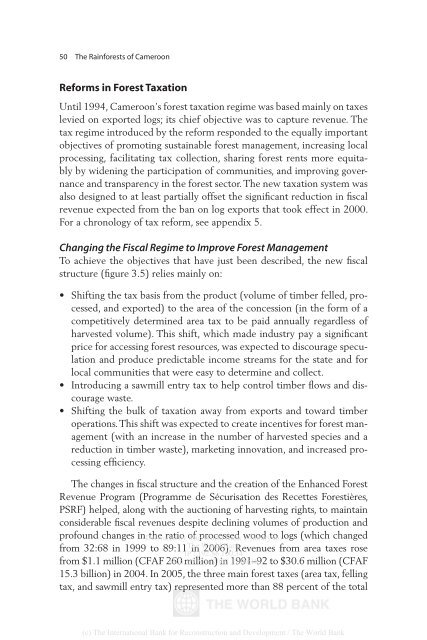The Rainforests of Cameroon - PROFOR
The Rainforests of Cameroon - PROFOR
The Rainforests of Cameroon - PROFOR
- No tags were found...
You also want an ePaper? Increase the reach of your titles
YUMPU automatically turns print PDFs into web optimized ePapers that Google loves.
50 <strong>The</strong> <strong>Rainforests</strong> <strong>of</strong> <strong>Cameroon</strong>Reforms in Forest TaxationUntil 1994, <strong>Cameroon</strong>’s forest taxation regime was based mainly on taxeslevied on exported logs; its chief objective was to capture revenue. <strong>The</strong>tax regime introduced by the reform responded to the equally importantobjectives <strong>of</strong> promoting sustainable forest management, increasing localprocessing, facilitating tax collection, sharing forest rents more equitablyby widening the participation <strong>of</strong> communities, and improving governanceand transparency in the forest sector. <strong>The</strong> new taxation system wasalso designed to at least partially <strong>of</strong>fset the significant reduction in fiscalrevenue expected from the ban on log exports that took effect in 2000.For a chronology <strong>of</strong> tax reform, see appendix 5.Changing the Fiscal Regime to Improve Forest ManagementTo achieve the objectives that have just been described, the new fiscalstructure (figure 3.5) relies mainly on:• Shifting the tax basis from the product (volume <strong>of</strong> timber felled, processed,and exported) to the area <strong>of</strong> the concession (in the form <strong>of</strong> acompetitively determined area tax to be paid annually regardless <strong>of</strong>harvested volume). This shift, which made industry pay a significantprice for accessing forest resources, was expected to discourage speculationand produce predictable income streams for the state and forlocal communities that were easy to determine and collect.• Introducing a sawmill entry tax to help control timber flows and discouragewaste.• Shifting the bulk <strong>of</strong> taxation away from exports and toward timberoperations. This shift was expected to create incentives for forest management(with an increase in the number <strong>of</strong> harvested species and areduction in timber waste), marketing innovation, and increased processingefficiency.<strong>The</strong> changes in fiscal structure and the creation <strong>of</strong> the Enhanced ForestRevenue Program (Programme de Sécurisation des Recettes Forestières,PSRF) helped, along with the auctioning <strong>of</strong> harvesting rights, to maintainconsiderable fiscal revenues despite declining volumes <strong>of</strong> production andpr<strong>of</strong>ound changes in Delivered the ratio by <strong>of</strong> <strong>The</strong> processed World Bank wood e-library to to: logs (which changedfrom 32:68 in 1999 to 89:11 <strong>The</strong> in World 2006). Bank Revenues from area taxes roseIP : 192.86.100.34from $1.1 million (CFAF 260 Mon, million) 09 Nov 2009 in 1991–92 17:06:18 to $30.6 million (CFAF15.3 billion) in 2004. In 2005, the three main forest taxes (area tax, fellingtax, and sawmill entry tax) represented more than 88 percent <strong>of</strong> the total(c) <strong>The</strong> International Bank for Reconstruction and Development / <strong>The</strong> World Bank
















